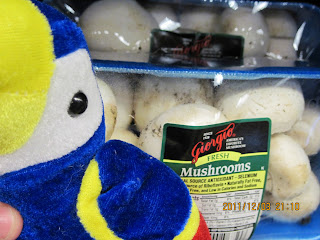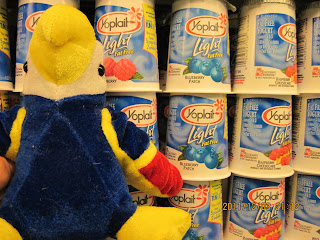Saturday, September 3, 2011
Cohesion
In this picture you can see that while it began to rain, the rain began to join together forming droplets on the windshield. This is because of the process of cohesion.
Sources:
Mrs. Beethe's notes.
Adhesion
Tape is a common form of an adhesive that we often use around the house so I decided it would make a good example for adhesion.
Sources:
Mrs. Beethe's notes.
Evaporative Cooling
Over the cup of boiling water you can see steam rising up, this steam helps in the process of evaportive cooling as it releases heat in the form of that steam to cool the water faster.
Sources:
Mrs. Beethe's notes.
Friday, September 2, 2011
Carnivore
This big fella is a fish found at the local aquarium and he is a carnivore because his diet is only based off of other meaty fish.
Sources:
Mrs. Beethe's notes.
Herbivores
Animals can be classified into three different types of dietary groups and those three are herbivores, carnivores and omnivores. Herbivores are consumers of producers and autotrophs as they eat mainly plants or fungi organisms. Herbivores are given their title because they stick to eating leafy greens and other plants, they do not however eat any forms of meat. Often herbivores tend to stay away from those that are meat eaters because they are creatures that hold nutrients that those meat eaters would consume in order to gain. A strange adaptation that these herbivores often have is that their teeth are more dull rather than sharp unlike carnivores because they do not use their teeth to sink into flesh of other animals. A few examples of herbivores would be koalas, llamas, cows and squirells.
Sources:
Mrs. Beethe's notes.
Sources:
Mrs. Beethe's notes.
Epistasis
My dumb little dog oreo is an example of the outcome of epistasis. His mother was a pure black toy poodle and his father was all white, his brother ended up being black like his mother but he ended up being a mix of both the black and white genes.
Epistasis is when there is an interaction going on between two or more genes to control a phenotypes behavior. The number of genes interacting with eachoter during epistasis can be found using the Mendelian Genetics chart to find their genetic ratio. Epistasis can affect color, shape, texture and a few other features of different organisms depending on what the genes differ with when being interacted with one another. An example of epistasis that was actually observed by Gregor Mendel himself was the pea pod genetic changes where he saw changes in varying pea pod plants that had grown into different shapes, sizes and colors.Sources:
McClean, Phillip. Gene Interactions. ndsu.edu. Retrieved September 2, 2011, from http://www.ndsu.edu/pubweb/~mcclean/plsc431/mendel/mendel6.htm
Thursday, September 1, 2011
Thermoregulation
I took this picture because my dog usually find ways to keep his body temperature maintained such as if it's too hot in the house he'll pant and release heat and like with the air conditioner he just enjoys the cool with his fur so he manages his body temperature using thermoregulation.
Sources:
Thermoregulation. harvard.edu. Retrieved September 1, 2011, from http://www.deas.harvard.edu/courses/es96/spring1997/web_page/health/thermreg.htm
Epithelial Tissue
The skin on my arm and hand are both considered epithelial tissue as they are located on the outter external part of my body.
Sources:
Epithelial Tissue. uwc.ac.za. Retrieved September 1, 2011, from http://www.bcb.uwc.ac.za/sci_ed/grade10/mammal/epithelial.htm
Invertabrates
Jellyfish are common forms of invertabrates and can move freely, their tentacles are an adaptation that they use to protect themselves.
Sources:
Mrs. Beethe's notes.
Fungi
Locally grown or found in the forests, mushrooms are a form of fungi that can be either enjoyable or deadly depending on what form of mushrooms they are.
Sources:
Mrs. Beethe's notes.
Bacteria
Yogurt such as these containers of Yoplait are forms of good bacteria that we can actually consume, not all bacteria is like that found in yogurt.
Sources:
Mrs. Beethe's notes.
Subscribe to:
Comments (Atom)










